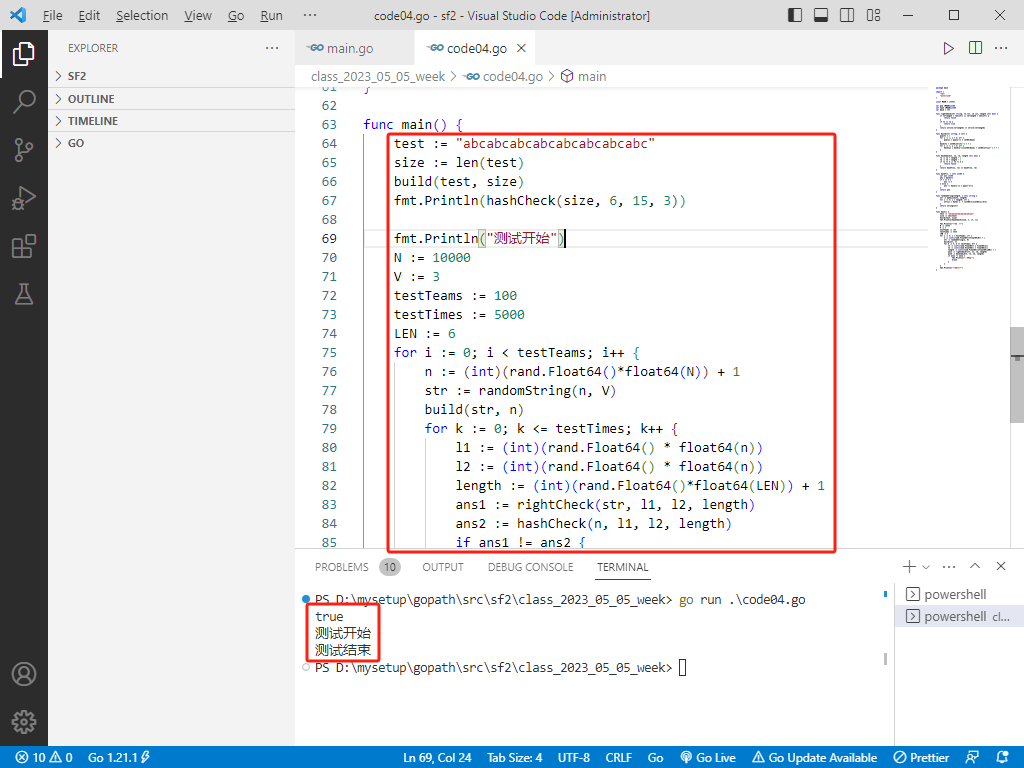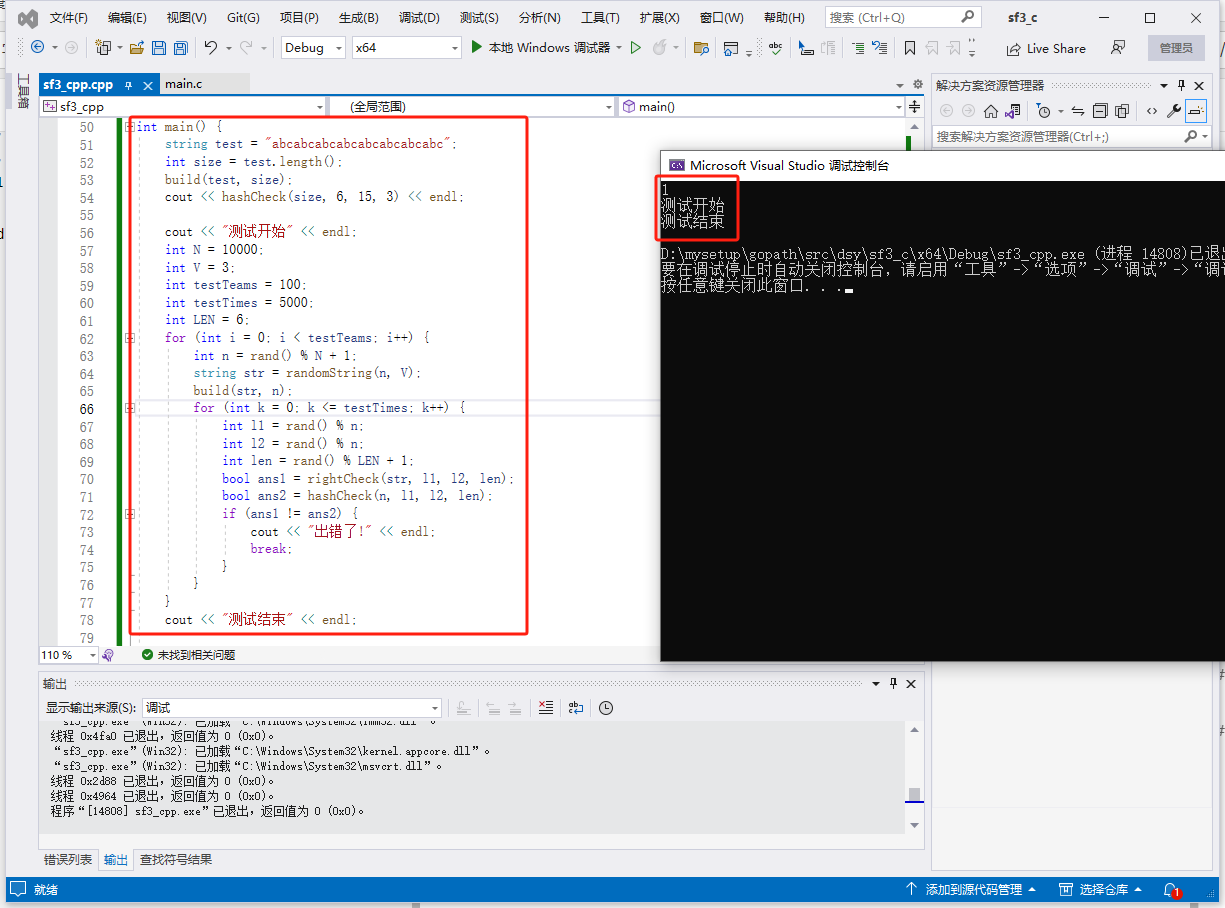2023-11-08:用 go 语言,字符串哈希原理和实现
比如 p = 233, 也就是课上说的选择的质数进制
" 3 1 2 5 6 ..."
0 1 2 3 4
hash[0] = 3 * p 的 0 次方
hash[1] = 3 * p 的 1 次方 + 1 * p 的 0 次方
hash[2] = 3 * p 的 2 次方 + 1 * p 的 1 次方 + 2 * p 的 0 次方
hash[3] = 3 * p 的 3 次方 + 1 * p 的 2 次方 + 2 * p 的 1 次方 + 5 * p 的 0 次方
hash[4] = 3 * p 的 4 次方 + 1 * p 的 3 次方 + 2 * p 的 2 次方 + 5 * p 的 1 次方 + 6 * p 的 0 次方
次方是倒过来的,课上讲错了
所以 hash[i] = hash[i-1] * p + arr[i],这个方式就可以得到上面说的意思
于是,你想得到子串"56"的哈希值
子串"56"的哈希值 = hash[4] - hash[2]*p 的 2 次方(就是子串"56"的长度次方)
hash[4] = 3 * p 的 4 次方 + 1 * p 的 3 次方 + 2 * p 的 2 次方 + 5 * p 的 1 次方 + 6 * p 的 0 次方
hash[2] = 3 * p 的 2 次方 + 1 * p 的 1 次方 + 2 * p 的 0 次方
hash[2] * p 的 2 次方 = 3 * p 的 4 次方 + 1 * p 的 3 次方 + 2 * p 的 2 次方
所以 hash[4] - hash[2] * p 的 2 次方 = 5 * p 的 1 次方 + 6 * p 的 0 次方
这样就得到子串"56"的哈希值了
抱歉,课上讲错了。应该是上面的方式。
所以,子串 s[l...r]的哈希值 = hash[r] - hash[l-1] * p 的(r-l+1)次方
也就是说,hash[l-1] * p 的(r-l+1)次方,正好和 hash[r]所代表的信息,前面对齐了
减完之后,正好就是子串 s[l...r]的哈希值。
来自左程云。
答案 2023-11-08:
go 和 c++代码用灵捷 3.5 编写,不需要修改。
大体过程如下:
rightCheck 函数的过程:
1.检查 l1 和 l2 是否超出字符串边界,如果超出则返回 false。
2.如果 l1 和 l2 相等,则直接返回 true。
3.判断从 l1 开始长度为 length 的子串和从 l2 开始长度为 length 的子串是否相等,如果相等则返回 true,否则返回 false。
hashCheck 函数的过程:
1.计算 l1 到 r1 和 l2 到 r2 两个子串的哈希值。
2.检查 r1 和 r2 是否超出字符串边界,如果超出则返回 false。
3.根据哈希值判断两个子串是否相等,如果相等则返回 true,否则返回 false。
rightCheck 函数的时间复杂度:O(length)
hashCheck 函数的时间复杂度:O(1)
rightCheck 函数的额外空间复杂度:O(1)
hashCheck 函数的额外空间复杂度:O(1)
go 完整代码如下:
package main
import ( "fmt" "math/rand")
const MAXN = 100005
var pow [MAXN]int64var hash [MAXN]int64var base = 499
func rightCheck(str string, l1 int, l2 int, length int) bool { if l1+length > len(str) || l2+length > len(str) { return false } if l1 == l2 { return true } return str[l1:l1+length] == str[l2:l2+length]}
func build(str string, n int) { pow[0] = 1 for j := 1; j < n; j++ { pow[j] = pow[j-1] * int64(base) } hash[0] = int64(str[0]-'a') + 1 for j := 1; j < n; j++ { hash[j] = hash[j-1]*int64(base) + int64(str[j]-'a') + 1 }}
func hashCheck(n, l1, l2, length int) bool { r1 := l1 + length - 1 r2 := l2 + length - 1 if r1 >= n || r2 >= n { return false } return hashf(l1, r1) == hashf(l2, r2)}
func hashf(l, r int) int64 { var ans int64 ans = hash[r] if l == 0 { ans -= 0 } else { ans -= hash[l-1] * pow[r-l+1] } return ans}
func randomString(length, v int) string { str := make([]byte, length) for i := 0; i < length; i++ { str[i] = byte('a' + (int64(v)*int64(i))%26) } return string(str)}
func main() { test := "abcabcabcabcabcabcabcabc" size := len(test) build(test, size) fmt.Println(hashCheck(size, 6, 15, 3))
fmt.Println("测试开始") N := 10000 V := 3 testTeams := 100 testTimes := 5000 LEN := 6 for i := 0; i < testTeams; i++ { n := (int)(rand.Float64()*float64(N)) + 1 str := randomString(n, V) build(str, n) for k := 0; k <= testTimes; k++ { l1 := (int)(rand.Float64() * float64(n)) l2 := (int)(rand.Float64() * float64(n)) length := (int)(rand.Float64()*float64(LEN)) + 1 ans1 := rightCheck(str, l1, l2, length) ans2 := hashCheck(n, l1, l2, length) if ans1 != ans2 { fmt.Println("出错了!") break } } } fmt.Println("测试结束")}
复制代码
c++完整代码如下:
#include <iostream>#include <string>#include <cstdlib>using namespace std;
const int MAXN = 100005;long long pow0[MAXN];long long hashArr[MAXN];int base = 499;
bool rightCheck(string str, int l1, int l2, int len) { if (l1 + len > str.length() || l2 + len > str.length()) { return false; } if (l1 == l2) { return true; } return str.substr(l1, len) == str.substr(l2, len);}
void build(string str, int n) { pow0[0] = 1; for (int j = 1; j < n; j++) { pow0[j] = pow0[j - 1] * base; }
hashArr[0] = str[0] - 'a' + 1; for (int j = 1; j < n; j++) { hashArr[j] = hashArr[j - 1] * base + str[j] - 'a' + 1; }}
bool hashCheck(int n, int l1, int l2, int len) { int r1 = l1 + len - 1; int r2 = l2 + len - 1; if (r1 >= n || r2 >= n) { return false; } return hashArr[l1 + len - 1] - (l1 == 0 ? 0 : hashArr[l1 - 1] * pow0[len]) == hashArr[l2 + len - 1] - (l2 == 0 ? 0 : hashArr[l2 - 1] * pow0[len]);}
string randomString(int len, int v) { string str; for (int i = 0; i < len; i++) { str += char('a' + rand() % v); } return str;}
int main() { string test = "abcabcabcabcabcabcabcabc"; int size = test.length(); build(test, size); cout << hashCheck(size, 6, 15, 3) << endl;
cout << "测试开始" << endl; int N = 10000; int V = 3; int testTeams = 100; int testTimes = 5000; int LEN = 6; for (int i = 0; i < testTeams; i++) { int n = rand() % N + 1; string str = randomString(n, V); build(str, n); for (int k = 0; k <= testTimes; k++) { int l1 = rand() % n; int l2 = rand() % n; int len = rand() % LEN + 1; bool ans1 = rightCheck(str, l1, l2, len); bool ans2 = hashCheck(n, l1, l2, len); if (ans1 != ans2) { cout << "出错了!" << endl; break; } } } cout << "测试结束" << endl;
return 0;}
复制代码












![2023-11-08:用go语言,字符串哈希原理和实现 比如p = 233, 也就是课上说的选择的质数进制 “ 3 1 2 5 6 ...“ 0 1 2 3 4 hash[0] = 3 * p的0_福大大架构师每日一题_福大大架构师每日一题_InfoQ写作社区](https://static001.infoq.cn/static/infoq/img/logo-121-75.yuij86g.png)
评论